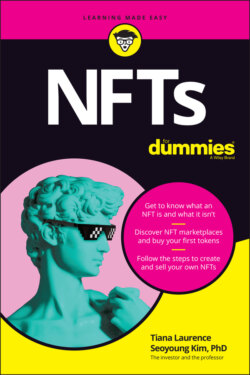Читать книгу NFTs For Dummies - Tiana Laurence - Страница 11
Beginning at the Beginning: What Is a Non-Fungible Good?
ОглавлениеAs you’ve likely learned from friends or Google searches before even purchasing this book, NFT stands for non-fungible token. Although tokens themselves are a relatively new development, the idea of grouping fungible and non-fungible goods is not.
Think of dollar bills, shares of Microsoft stock, and Bitcoin — each represent a defined set where items within the set are fungible. Put simply, we don’t care which dollar bills we receive as long as we receive the right quantity, since each dollar bill fulfills the same purpose and obligations as another.
Non-fungible goods are also a regular and far more prevalent part of our lives. Apples at the grocery store, orchids from the florist, and tickets to an upcoming concert — we inspect our fruit and our flowers to select the ones that are less wilted or bruised. With concerts, each ticket represents a different seat, and a front-row seat is not happily exchanged for a seat that’s far removed.
By their nature, non-fungible goods are more difficult to systematically record and track. For one, they require more information to be stored to denote their unique differences. While we can’t digitalize the world, there are many instances where we would greatly benefit from a reliable, transparent, and automated system designed to group, organize, and digitally track non-fungible things that are important to us. Here’s where NFTs come into play!
A non-fungible token (NFT) is a unique digital identifier that’s secured and stored on a public blockchain. One token is not interchangeable for another, and a token cannot be further divided.
What an NFT actually represents depends on the intent of the developers. Much like how a cryptocurrency — or a fungible token — can represent a global medium of exchange (Bitcoin), a utility token used to fuel smart contracts (Ether), or a financial security linked to shares in a fund (BCAP), NFTs also differ in their current and potential uses.
Although general interest in NFTs has been minimal to nonexistent until recently, the development community has been teeming with fungible token activity for years. Following the successful launchings of Bitcoin (2009), Litecoin (2011), and Dogecoin (2013), a surge of projects followed, each spawning their own fungible tokens. Amidst this crypto-wave, developers began to envision a world of digital collectibles — the crypto-analogue of beanie babies and baseball cards. These projects required a different type of token standard to ensure the uniqueness and non-divisibility of each crypto-baby or crypto-card.
Finally, with the overwhelming success of CryptoKitties, a non-fungible token on Ethereum that debuted in 2017, the ERC-721 Non-Fungible Token Standard soon followed to serve as a blueprint for the development community. (Read more about CryptoKitties in Chapter 2.) Since then, there’s been an explosion of NFT projects, with more than 15,000 NFTs deployed on Ethereum alone. (See Figure 1-4.)
FIGURE 1-4: The five most active NFTs.
